热门标签
热门文章
- 1【并发编程四】windows进程通信和Linux进程通信_windows linux消息队列,用于进程间消息同步
- 2电子班牌解决方案-最新全套文件_电子班牌系统施工方案
- 3redis,memcache二者的区别比较及redis应用场景_memcache和redis的区别和应用场景
- 4Javase-初识Java
- 5私有GitLab仓库 - 本地搭建GitLab私有代码仓库并随时远程访问「内网穿透」_gitlab私有部署
- 6Java中Map高效率遍历的方式_map遍历效率最高
- 7Redis分布式缓存
- 8【论文阅读】VMamba:视觉状态空间模型_visual mamba块(vss)
- 9樊政谈人才职场成功最重要的53句话_详细可行的职业生涯规划是人才成功的基石是谁说的
- 10libtest (native:platform) should not link to libmi3 (native:vendor)_(native:platform) can not link against libdiag (na
当前位置: article > 正文
python毕业设计 大数据电商用户行为分析及可视化_基于电商平台数据的用户购买行为分析与可视化
作者:2023面试高手 | 2024-05-16 17:17:39
赞
踩
基于电商平台数据的用户购买行为分析与可视化
1. 数据集说明
这是一份来自淘宝的用户行为数据,时间区间为 2017-11-25 到 2017-12-03,总计 100,150,807 条记录,大小为 3.5 G,包含 5 个字段。
选题指导,项目分享:
https://gitee.com/yaa-dc/warehouse-1/blob/master/python/README.md
2. 数据处理
2.1 数据导入
将数据加载到 hive, 然后通过 hive 对数据进行数据处理。
-- 建表 drop table if exists user_behavior; create table user_behavior ( `user_id` string comment '用户ID', `item_id` string comment '商品ID', `category_id` string comment '商品类目ID', `behavior_type` string comment '行为类型,枚举类型,包括(pv, buy, cart, fav)', `timestamp` int comment '行为时间戳', `datetime` string comment '行为时间') row format delimited fields terminated by ',' lines terminated by '\n'; -- 加载数据 LOAD DATA LOCAL INPATH '/home/getway/UserBehavior.csv' OVERWRITE INTO TABLE user_behavior ;
- 1
- 2
- 3
- 4
- 5
- 6
- 7
- 8
- 9
- 10
- 11
- 12
- 13
- 14
- 15
- 16
2.2 数据清洗
数据处理主要包括:删除重复值,时间戳格式化,删除异常值。
--数据清洗,去掉完全重复的数据 insert overwrite table user_behavior select user_id, item_id, category_id, behavior_type, timestamp, datetime from user_behavior group by user_id, item_id, category_id, behavior_type, timestamp, datetime; --数据清洗,时间戳格式化成 datetime insert overwrite table user_behavior select user_id, item_id, category_id, behavior_type, timestamp, from_unixtime(timestamp, 'yyyy-MM-dd HH:mm:ss') from user_behavior; --查看时间是否有异常值 select date(datetime) as day from user_behavior group by date(datetime) order by day; --数据清洗,去掉时间异常的数据 insert overwrite table user_behavior select user_id, item_id, category_id, behavior_type, timestamp, datetime from user_behavior where cast(datetime as date) between '2017-11-25' and '2017-12-03'; --查看 behavior_type 是否有异常值 select behavior_type from user_behavior group by behavior_type;
- 1
- 2
- 3
- 4
- 5
- 6
- 7
- 8
- 9
- 10
- 11
- 12
- 13
- 14
- 15
- 16
- 17
- 18
- 19
- 20
- 21
- 22
3.数据分析可视化
3.1 用户流量及购物情况
--总访问量PV,总用户量UV
select sum(case when behavior_type = 'pv' then 1 else 0 end) as pv,
count(distinct user_id) as uv
from user_behavior;
- 1
- 2
- 3
- 4
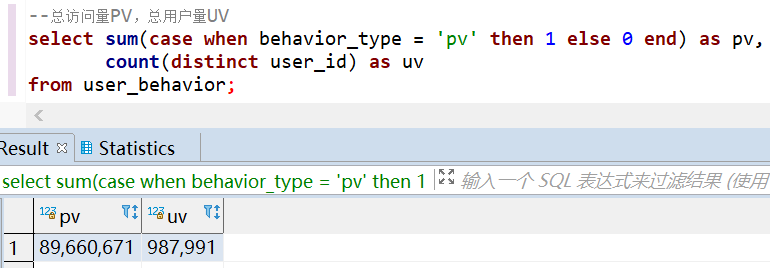
--日均访问量,日均用户量
select cast(datetime as date) as day,
sum(case when behavior_type = 'pv' then 1 else 0 end) as pv,
count(distinct user_id) as uv
from user_behavior
group by cast(datetime as date)
order by day;
- 1
- 2
- 3
- 4
- 5
- 6
- 7
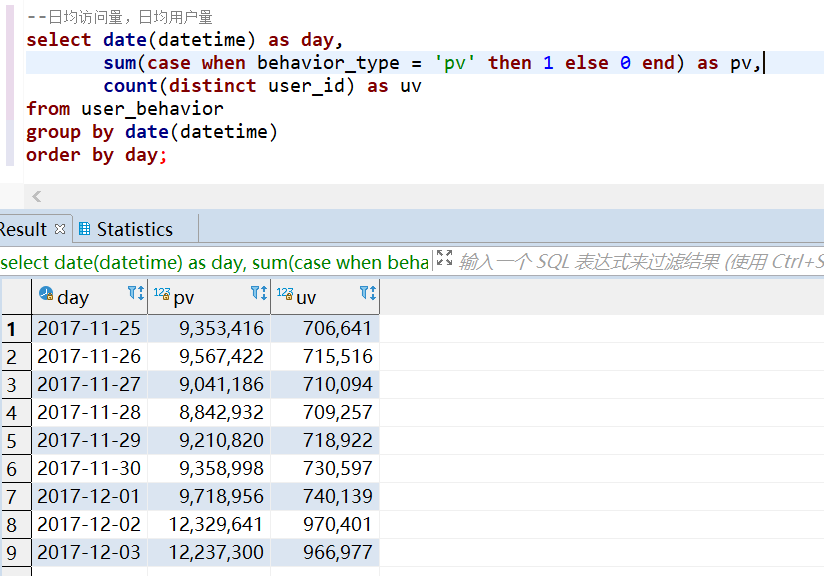
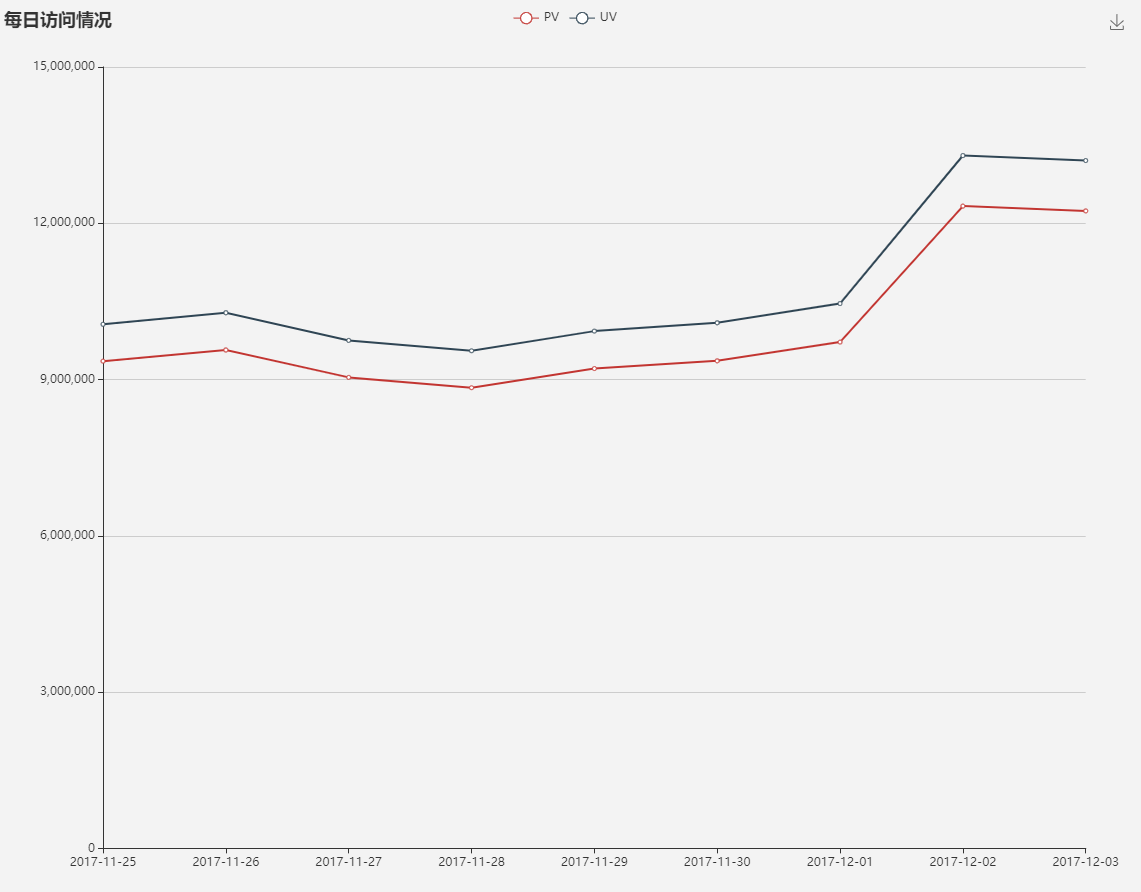
--每个用户的购物情况,加工到 user_behavior_count
create table user_behavior_count as
select user_id,
sum(case when behavior_type = 'pv' then 1 else 0 end) as pv, --点击数
sum(case when behavior_type = 'fav' then 1 else 0 end) as fav, --收藏数
sum(case when behavior_type = 'cart' then 1 else 0 end) as cart, --加购物车数
sum(case when behavior_type = 'buy' then 1 else 0 end) as buy --购买数
from user_behavior
group by user_id;
--复购率:产生两次或两次以上购买的用户占购买用户的比例
select sum(case when buy > 1 then 1 else 0 end) / sum(case when buy > 0 then 1 else 0 end)
from user_behavior_count;
- 1
- 2
- 3
- 4
- 5
- 6
- 7
- 8
- 9
- 10
- 11
- 12
- 13

- 小结:2017-11-25 到 2017-12-03 这段时间,PV 总数为 89,660,671 ,UV 总数为 987,991。从日均访问量趋势来看,进入 12 月份之后有一个比较明显的增长,猜测可能是因为临近双 12 ,电商活动引流产生,另外,2017-12-02 和 2017-12-03 刚好是周末,也可能是周末的用户活跃度本来就比平常高。总体的复购率为 66.01%,说明用户的忠诚度比较高。
3.2 用户行为转换率
--点击/(加购物车+收藏)/购买 , 各环节转化率 select a.pv, a.fav, a.cart, a.fav + a.cart as `fav+cart`, a.buy, round((a.fav + a.cart) / a.pv, 4) as pv2favcart, round(a.buy / (a.fav + a.cart), 4) as favcart2buy, round(a.buy / a.pv, 4) as pv2buy from( select sum(pv) as pv, --点击数 sum(fav) as fav, --收藏数 sum(cart) as cart, --加购物车数 sum(buy) as buy --购买数 from user_behavior_count ) as a;
- 1
- 2
- 3
- 4
- 5
- 6
- 7
- 8
- 9
- 10
- 11
- 12
- 13
- 14
- 15
- 16
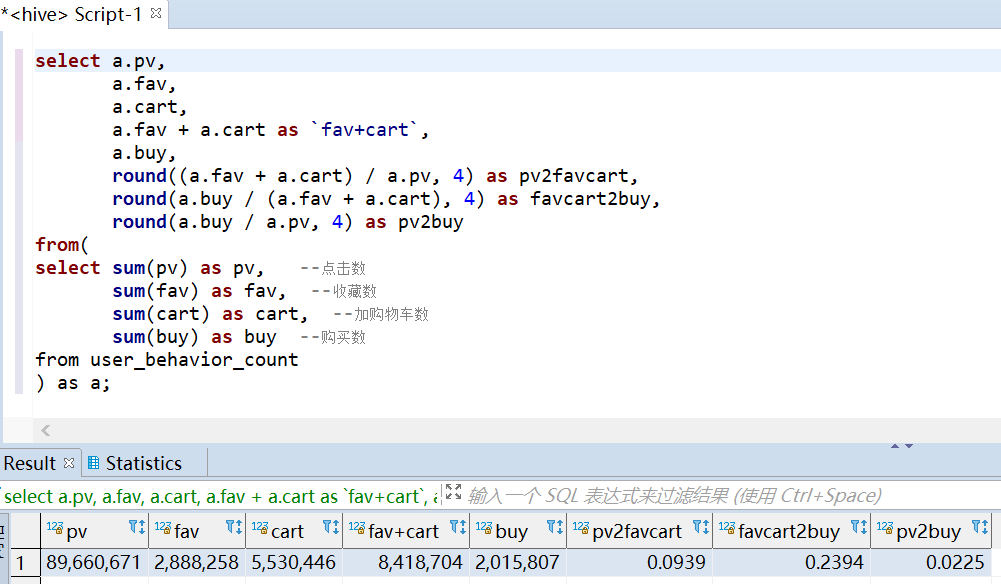
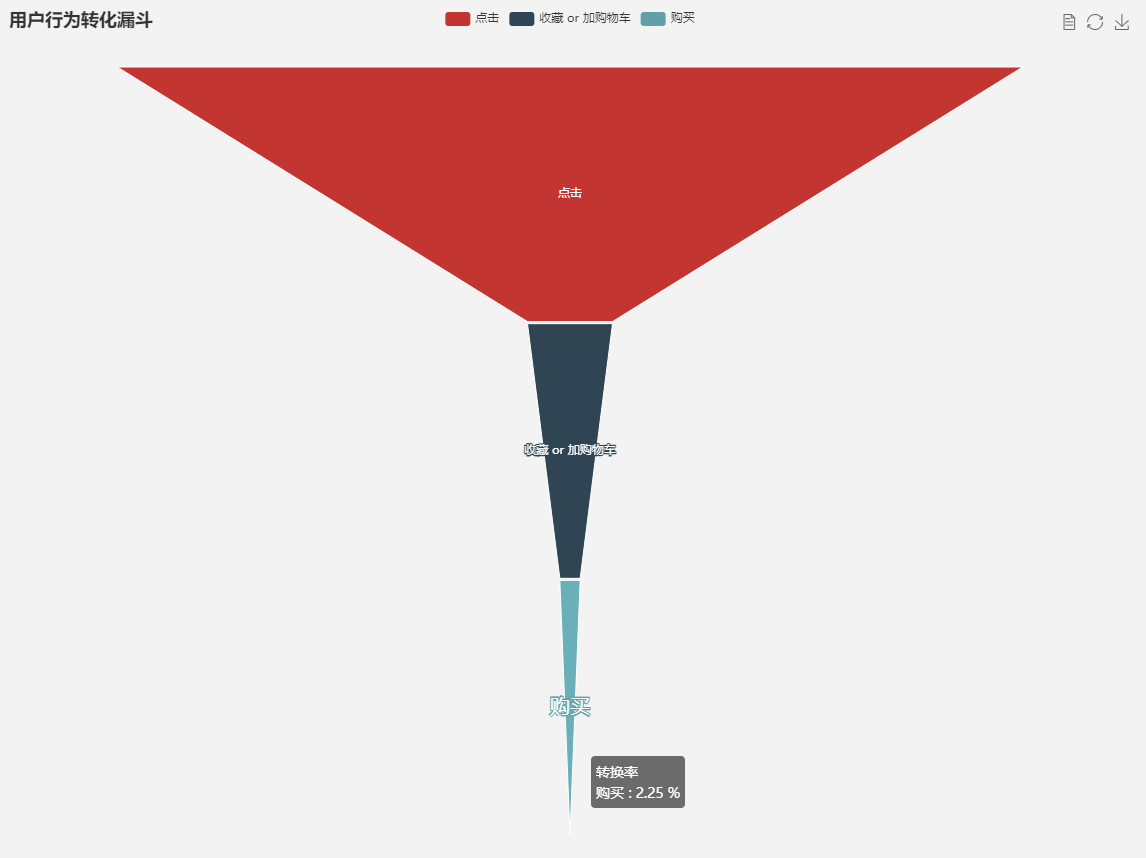
- 小结:2017-11-25 到 2017-12-03 这段时间,点击数为 89,660,671 ,收藏数为 2,888,258,加购物车数为5,530,446,购买数为 2,015,807。总体的转化率为 2.25%,这个值可能是比较低的,从加到购物车数来看,有可能部分用户是准备等到电商节日活动才进行购买。所以合理推断:一般电商节前一段时间的转化率会比平常低。
3.3 用户行为习惯
-- 一天的活跃时段分布
select hour(datetime) as hour,
sum(case when behavior_type = 'pv' then 1 else 0 end) as pv, --点击数
sum(case when behavior_type = 'fav' then 1 else 0 end) as fav, --收藏数
sum(case when behavior_type = 'cart' then 1 else 0 end) as cart, --加购物车数
sum(case when behavior_type = 'buy' then 1 else 0 end) as buy --购买数
from user_behavior
group by hour(datetime)
order by hour;
- 1
- 2
- 3
- 4
- 5
- 6
- 7
- 8
- 9
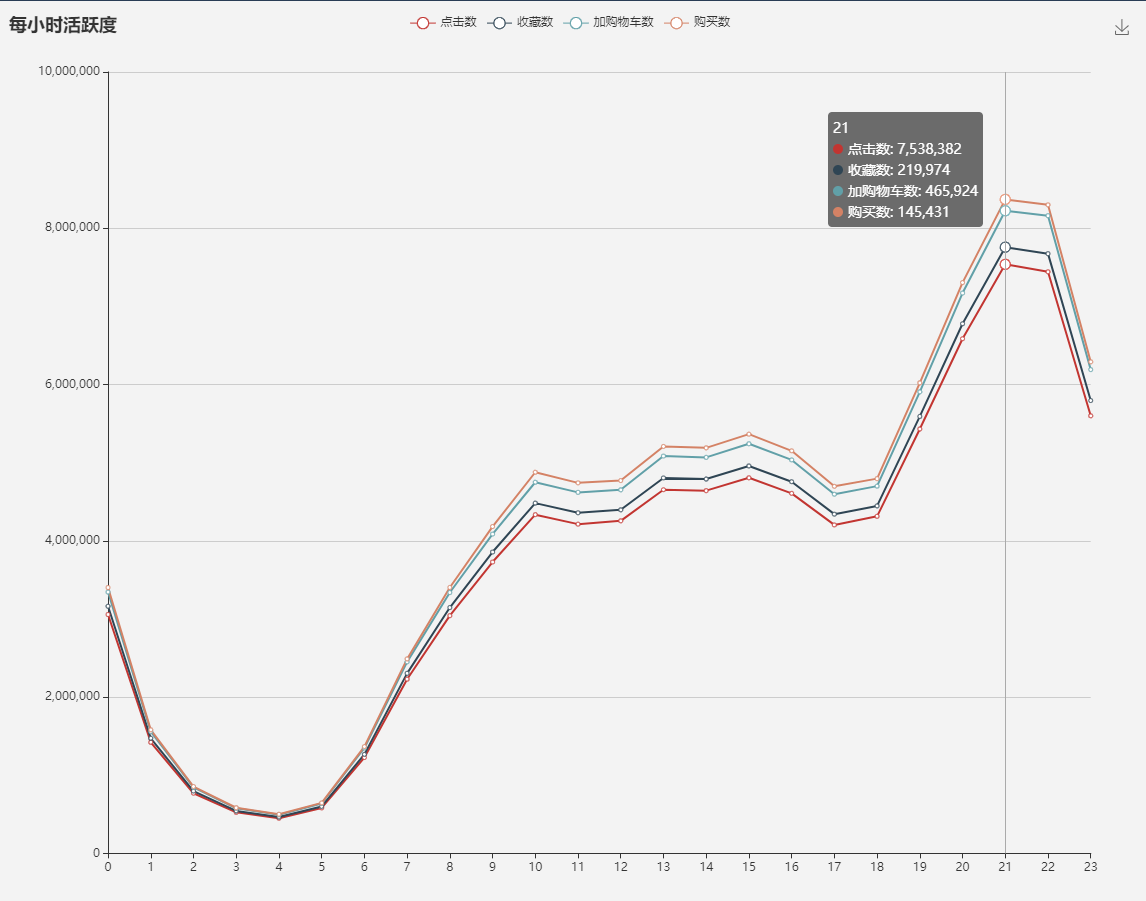
--一周用户的活跃分布
select pmod(datediff(datetime, '1920-01-01') - 3, 7) as weekday,
sum(case when behavior_type = 'pv' then 1 else 0 end) as pv, --点击数
sum(case when behavior_type = 'fav' then 1 else 0 end) as fav, --收藏数
sum(case when behavior_type = 'cart' then 1 else 0 end) as cart, --加购物车数
sum(case when behavior_type = 'buy' then 1 else 0 end) as buy --购买数
from user_behavior
where date(datetime) between '2017-11-27' and '2017-12-03'
group by pmod(datediff(datetime, '1920-01-01') - 3, 7)
order by weekday;
- 1
- 2
- 3
- 4
- 5
- 6
- 7
- 8
- 9
- 10
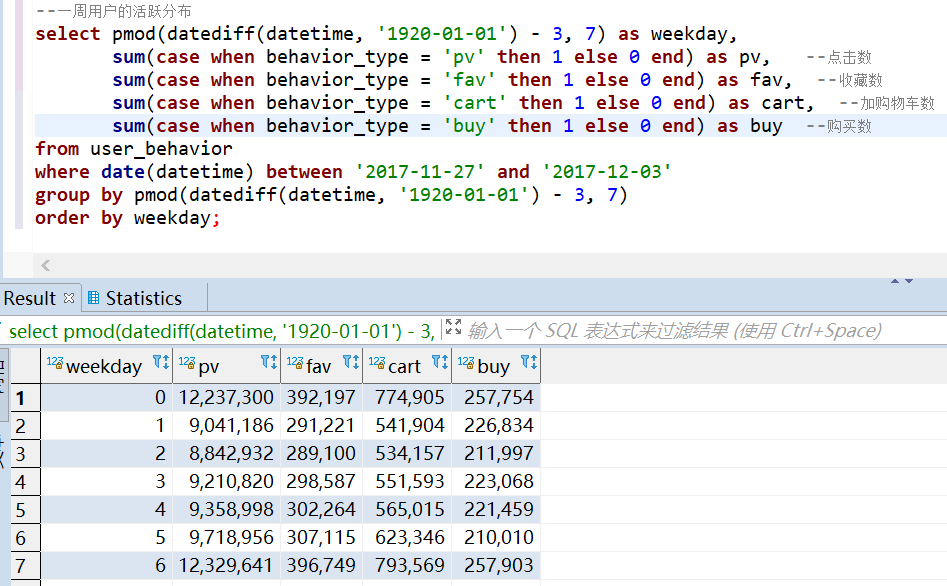
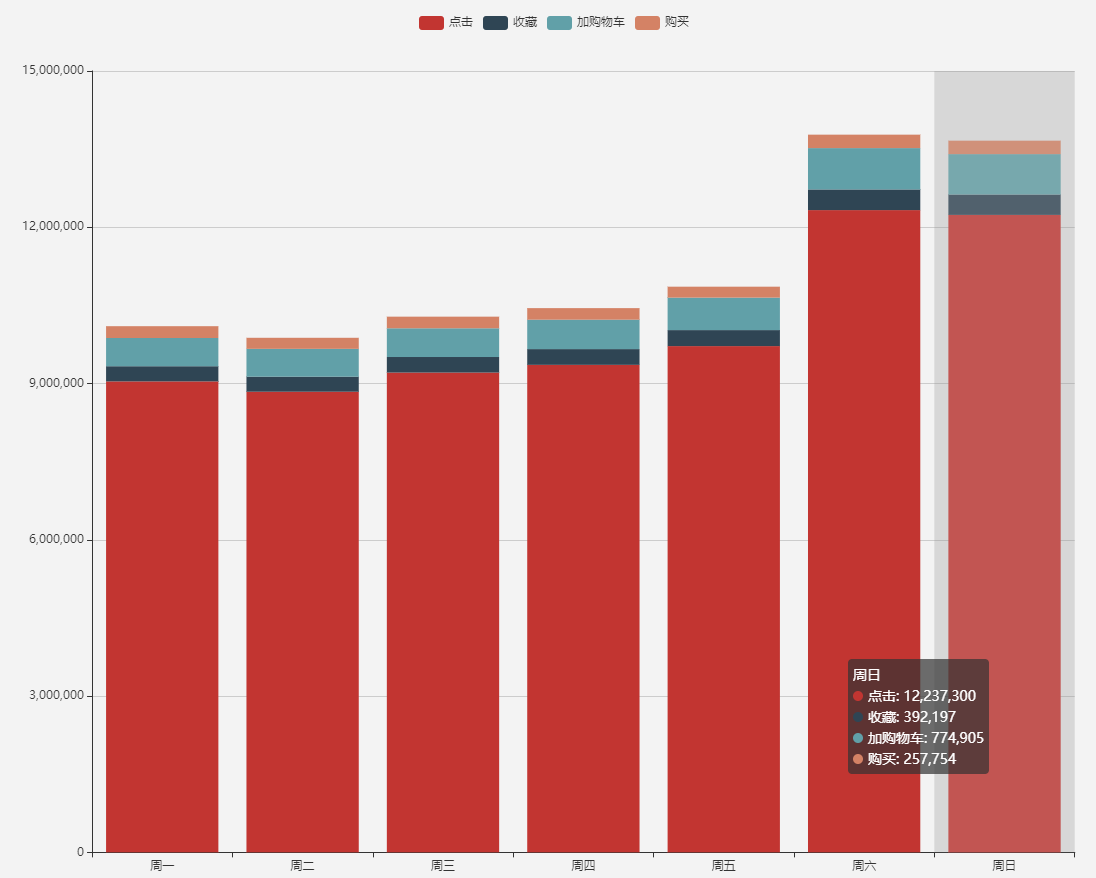
- 小结:晚上21点-22点之间是用户一天中最活跃的时候,凌晨 4 点,则是活跃度最低的时候。一周中,工作日活跃度都差不多,到了周末活跃度有明显提高。
3.4 基于 RFM 模型找出有价值的用户
RFM 模型是衡量客户价值和客户创利能力的重要工具和手段,其中由3个要素构成了数据分析最好的指标,分别是:
- R-Recency(最近一次购买时间)
- F-Frequency(消费频率)
- M-Money(消费金额)
--R-Recency(最近一次购买时间), R值越高,一般说明用户比较活跃 select user_id, datediff('2017-12-04', max(datetime)) as R, dense_rank() over(order by datediff('2017-12-04', max(datetime))) as R_rank from user_behavior where behavior_type = 'buy' group by user_id limit 10; --F-Frequency(消费频率), F值越高,说明用户越忠诚 select user_id, count(1) as F, dense_rank() over(order by count(1) desc) as F_rank from user_behavior where behavior_type = 'buy' group by user_id limit 10; --M-Money(消费金额),数据集无金额,所以就不分析这一项
- 1
- 2
- 3
- 4
- 5
- 6
- 7
- 8
- 9
- 10
- 11
- 12
- 13
- 14
- 15
- 16
- 17
- 18
- 19
对有购买行为的用户按照排名进行分组,共划分为5组,
前 - 1/5 的用户打5分
前 1/5 - 2/5 的用户打4分
前 2/5 - 3/5 的用户打3分
前 3/5 - 4/5 的用户打2分
前 4/5 - 的用户打1分
按照这个规则分别对用户时间间隔排名打分和购买频率排名打分,最后把两个分数合并在一起作为该名用户的最终评分
with cte as( select user_id, datediff('2017-12-04', max(datetime)) as R, dense_rank() over(order by datediff('2017-12-04', max(datetime))) as R_rank, count(1) as F, dense_rank() over(order by count(1) desc) as F_rank from user_behavior where behavior_type = 'buy' group by user_id) select user_id, R, R_rank, R_score, F, F_rank, F_score, R_score + F_score AS score from( select *, case ntile(5) over(order by R_rank) when 1 then 5 when 2 then 4 when 3 then 3 when 4 then 2 when 5 then 1 end as R_score, case ntile(5) over(order by F_rank) when 1 then 5 when 2 then 4 when 3 then 3 when 4 then 2 when 5 then 1 end as F_score from cte ) as a order by score desc limit 20;
- 1
- 2
- 3
- 4
- 5
- 6
- 7
- 8
- 9
- 10
- 11
- 12
- 13
- 14
- 15
- 16
- 17
- 18
- 19
- 20
- 21
- 22
- 23
- 24
- 25
- 26
- 27
- 28
- 29
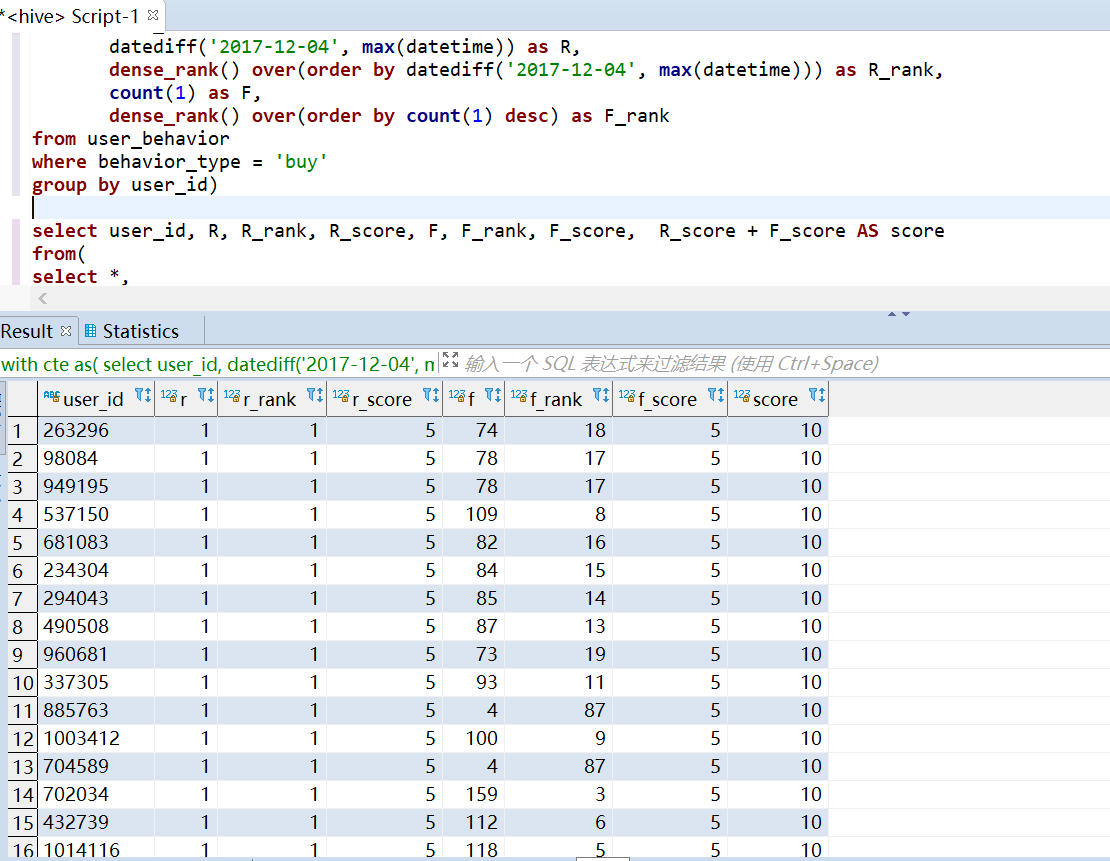
- 小结:可以根据用户的价值得分,进行个性化的营销推荐。
3.5 商品维度的分析
--销量最高的商品 select item_id , sum(case when behavior_type = 'pv' then 1 else 0 end) as pv, --点击数 sum(case when behavior_type = 'fav' then 1 else 0 end) as fav, --收藏数 sum(case when behavior_type = 'cart' then 1 else 0 end) as cart, --加购物车数 sum(case when behavior_type = 'buy' then 1 else 0 end) as buy --购买数 from user_behavior group by item_id order by buy desc limit 10; --销量最高的商品大类 select category_id , sum(case when behavior_type = 'pv' then 1 else 0 end) as pv, --点击数 sum(case when behavior_type = 'fav' then 1 else 0 end) as fav, --收藏数 sum(case when behavior_type = 'cart' then 1 else 0 end) as cart, --加购物车数 sum(case when behavior_type = 'buy' then 1 else 0 end) as buy --购买数 from user_behavior group by category_id order by buy desc limit 10;
- 1
- 2
- 3
- 4
- 5
- 6
- 7
- 8
- 9
- 10
- 11
- 12
- 13
- 14
- 15
- 16
- 17
- 18
- 19
- 20
- 21
- 小结:缺失商品维表,所以没有太多分析价值。假如有商品维表,可以再展开,以商品纬度进行分析,比如不同行业、不同产品的转化率,还有竞品分析等等。
选题指导,项目分享:
https://gitee.com/yaa-dc/warehouse-1/blob/master/python/README.md
声明:本文内容由网友自发贡献,不代表【wpsshop博客】立场,版权归原作者所有,本站不承担相应法律责任。如您发现有侵权的内容,请联系我们。转载请注明出处:https://www.wpsshop.cn/w/2023面试高手/article/detail/579759
推荐阅读
相关标签



